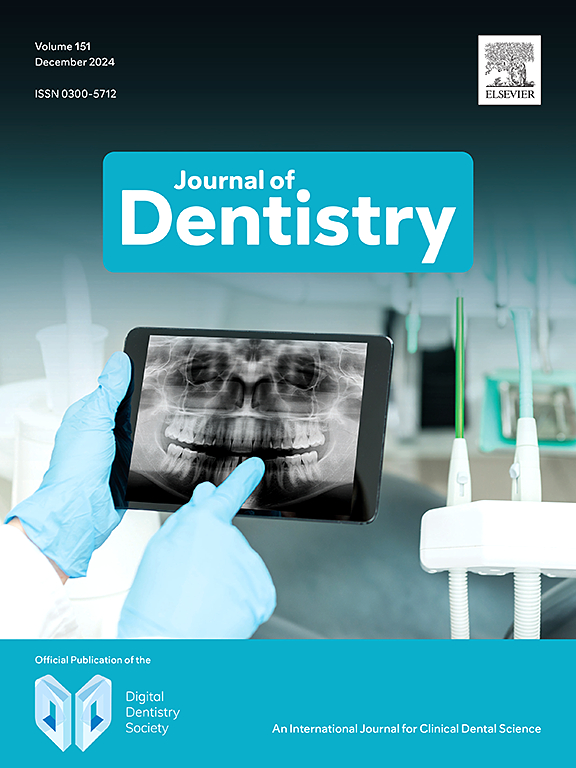在一项聚类随机对照试验中,疗养院口腔健康恢复和再指导的成本-效果分析。
IF 4.8
2区 医学
Q1 DENTISTRY, ORAL SURGERY & MEDICINE
引用次数: 0
摘要
研究目的我们在 18 家德国养老院(NH)开展了一项分组随机对照试验(cRCT),以评估牙科助理(DAs)在 13 个月内对护理人员进行再教育和再激励的成本效益:在干预组中,牙医对养老院居民进行检查,确定口腔健康状况,并开出个性化口腔护理干预处方。护理人员在牙医助理的定期跟踪支持下实施这些干预措施(再指导和再激励)。在对照组中,类似的干预措施是通过标准表格开具的,没有再指导和再激励(标准护理)。主要结果是使用老年/普通口腔健康评估指数(ADD-GOHAI)得出的口腔健康相关生活质量(OHrQoL)。次要结果包括使用 EQ-5D 指数和龋病经验(DMFT 指数)得出的与健康相关的生活质量(HrQoL)。成本(包括人员、材料和差旅成本)以 2022 欧元为单位进行评估。成本效益比和引导模拟评估了不同支付意愿阈值下的成本效益可接受性:在招募的 358 名参与者中,干预组和对照组分别有 68 人和 63 人完成了研究。干预组和对照组的人口统计学和基线健康指标无明显差异。13 个月后,干预组的 ADD-GOHAI 和 DMFT 评分变化很小且不显著,而 EQ-5D 评分有所下降(p < 0.001)。干预组的总费用(中位数为 121.10 欧元)高于对照组(中位数为 0 欧元,p < 0.001),主要原因是差旅费用。干预增加了牙科服务的使用,但成本效益的可接受性较低:由牙科医生主导的再造手术并未改善患者的健康质量生活水平,反而对其健康质量生活水平产生了负面影响,并增加了成本。值得注意的是,我们的研究存在严重的自然减员现象,影响了统计能力:临床意义:牙科助理的再建和再激励并没有改善患者的 OHrQoL,但却产生了大量费用,这主要是由于牙科服务的增加:试验注册:ClinicalTrials.gov(试验注册号 NCT04140929)。本文章由计算机程序翻译,如有差异,请以英文原文为准。
Cost-effectiveness-analysis of oral health remotivation and reinstruction in nursing homes in a cluster-randomized controlled trial
Objectives
We conducted a cluster-randomized-controlled trial (cRCT) in 18 German nursing homes (NH) to evaluate the cost-effectiveness of reinstruction and remotivation of nursing staff by dental assistants (DAs) over 13 months.
Methods
In the intervention arm, dentists examined NH residents, identified oral health conditions, and prescribed individualized oral care interventions. Nursing staff delivered these interventions, with regular follow-up support from DAs (reinstruction and remotivation). In the control group, similar interventions were prescribed via a standardized form, without reinstruction and remotivation (standard of care). The primary outcome was Oral-Health-related Quality-of-Life (OHrQoL) using the Geriatric/General Oral Health Assessment Index (ADD-GOHAI). Secondary outcomes included Health-related Quality-of-Life (HrQoL) using the EQ-5D summary index and caries experience (DMFT index). Costs, including those for staff, materials, and travel, were assessed in Euro 2022. Cost-effectiveness ratios and bootstrapping simulations assessed cost-effectiveness-acceptability at different willingness-to-pay thresholds.
Results
Of 358 recruited participants, 68 and 63 in the intervention and control group completed the study. No significant differences existed between groups in demographics or baseline health measures. After 13 months, changes in ADD-GOHAI and DMFT scores were minimal and non-significant, while EQ-5D scores decreased in the intervention group (p < 0.001). Total costs were higher in the intervention arm (median 121.10 Euro) versus the control (median 0 Euro, p < 0.001), mainly due to travel expenses. The intervention increased dental service use but demonstrated lower cost-effectiveness acceptability.
Conclusions
DA-led reinstruction did not improve OHrQoL, negatively impacted HrQoL, and increased costs. Notably, our study was suffering from significant attrition, impacting on statistical power.
Clinical significance
Reinstruction and remotivation by dental assistants did not improve OHrQoL, but generated significant costs, mainly due to an uptake of dental services.
Trial registration
: ClinicalTrials.gov (Trial registration number NCT04140929)
求助全文
通过发布文献求助,成功后即可免费获取论文全文。
去求助
来源期刊

Journal of dentistry
医学-牙科与口腔外科
CiteScore
7.30
自引率
11.40%
发文量
349
审稿时长
35 days
期刊介绍:
The Journal of Dentistry has an open access mirror journal The Journal of Dentistry: X, sharing the same aims and scope, editorial team, submission system and rigorous peer review.
The Journal of Dentistry is the leading international dental journal within the field of Restorative Dentistry. Placing an emphasis on publishing novel and high-quality research papers, the Journal aims to influence the practice of dentistry at clinician, research, industry and policy-maker level on an international basis.
Topics covered include the management of dental disease, periodontology, endodontology, operative dentistry, fixed and removable prosthodontics, dental biomaterials science, long-term clinical trials including epidemiology and oral health, technology transfer of new scientific instrumentation or procedures, as well as clinically relevant oral biology and translational research.
The Journal of Dentistry will publish original scientific research papers including short communications. It is also interested in publishing review articles and leaders in themed areas which will be linked to new scientific research. Conference proceedings are also welcome and expressions of interest should be communicated to the Editor.
 求助内容:
求助内容: 应助结果提醒方式:
应助结果提醒方式:


